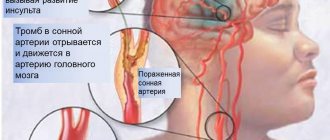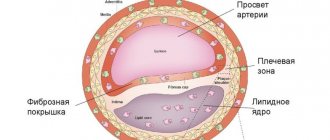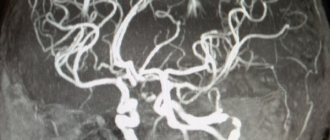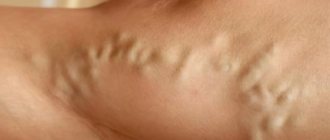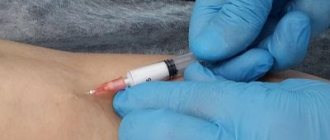Around the so-called “vascular cleansing”
A whole industry and many myths have developed.
However, our blood vessels are not pipes; even theoretically, cleaning them to get rid of cholesterol plaques or calcium deposits is not at all so simple. Does “vascular cleaning” even exist, or is it a misconception and a marketing ploy? We talked with our expert - cardiologist, functional diagnostics doctor, candidate of medical sciences Anna Nikolaevna Kotelnikova
, to learn more about the prevention and treatment of atherosclerosis.
On the eve of the New Year and the festive feast, be attentive to your diet and take care of yourself!
Vessel cleaning - what is it?
In official medical terminology, there is no such thing as “cleaning blood vessels” - this is everyday slang that is misleading and creates confusion. Unfortunately, it is impossible to remove cholesterol plaques that have already formed and clean a clogged vessel like a water pipe using a magic cleaning agent or “nanothreads”. An entire industry has already formed around the cleaning of blood vessels, however, the drugs and procedures that are offered to solve the problem do not have proven clinical effectiveness, the same applies to traditional methods. Restoring the functional state of the vascular endothelium is much more serious than detox, which is only appropriate for the primary prevention of vascular blockage. With atherosclerosis, when the vessels are narrowed by less than 50%, there is a risk of blood clots, heart attack or stroke
, the doctor prescribes drug therapy (
statins
,
calcium antagonists
and other drugs). However, they do not remove plaques, but compact them, thus increasing the lumen of the vessel. Therefore, it is extremely important to adhere to simple recommendations for the prevention of atherosclerosis.
In colloquial language, “cleaning” is also called cardiac surgery to expand a dangerously narrowed vessel - angioplasty, bypass surgery, stenting
. Their methods differ, but the essence is approximately the same: a catheter is inserted into the vessel, and the damaged, pathologically narrowed area is straightened and strengthened from the inside using implants - special rings, springs or tubes. The need for such operations arises if an atherosclerotic plaque closes the lumen of the vessel (artery) by more than 50%. When the blood supply is so disrupted, cells and organs are not supplied with oxygen and nutrients, and a person’s life can hang by a thread. It happens that a vessel or artery is blocked by a blood clot - a person suddenly feels very tired to the point of loss of consciousness, rapid heartbeat, suspicious pain (headaches, in the area of the heart), suffocates, and the skin turns pale. Such conditions are considered acute, and as a “cleansing” procedure, thrombolysis with special drugs is used on an outpatient basis. After stenting, bypass surgery or angioplasty, blood supply is restored, but it is necessary to take special medications and be observed by a cardiologist.
Why do blood vessels become clogged?
Vessels become blocked for various reasons, but most often this occurs due to cholesterol plaques and the deposition of calcium salts (calcinosis). The mechanism for the formation of such blockages is more complex than it seems, and it lies behind our everyday habits - even the most harmless at first glance. For example, when we eat highly salty foods
, blood thickening and fluid retention occur - blood pressure increases.
When we experience stress
, the hormones adrenaline and norepinephrine are produced - key vessels narrow, and pressure increases because the amount of blood that the heart needs to push remains unchanged. In a normal healthy state, the vessels cope with such loads, but over time, serious problems can begin, and this is not only hypertension.
Causes of atherosclerosis
The fact is that due to systematic additional loads, microdamages can form on the walls of the arteries. Damaged tissues swell. Cells that respond to inflammation (for example, white blood cells) accumulate around the damage, and fat and cholesterol that float in the blood also cling to them - a cholesterol plaque is formed. It is no longer possible to get rid of it using completely non-invasive methods. At the same time, the walls of the vessels become coarser and thinner - this pathological condition is called atherosclerosis, which in turn can lead to coronary artery disease and causes the need for “cleansing of blood vessels”.
Thus, it is important not only to eat right, but also to maintain the functional state of the cardiovascular system.
Possible complications
Without timely and correct treatment, cholesterol plaques provoke serious consequences:
| Name | Description |
| Trophic ulcers of the feet and legs | Poor blood circulation leads to decreased immunity. Against the background of deterioration of regeneration processes, inflammation develops. Pathological changes are difficult to treat. A chronic inflammatory process leads to the occurrence of tissue necrosis. The skin becomes covered with open wounds with repeated relapses. |
| Gangrene | The resulting plaques clog the arteries, provoke vasospasm, which leads to cessation of blood circulation in the lower and upper extremities. Living tissues die and their color changes. As a result, the affected organ is amputated. |
| Myocardial infarction | In most cases (98%), the cause of the pathology is plaques that form in the aorta. Ischemic necrosis occurs in the area of the heart muscle. |
| Stroke | High cholesterol causes narrowing and blockage of the cerebral artery, which is located in the brain. The pathological condition leads to decreased blood flow. Vascular changes provoke irreversible consequences in tissues. As a result, neurological disorders develop, which entail not only disability, but also death. |
| Organ ischemia | Cholesterol plaques disrupt the functioning of any internal organ in the human body. They damage blood vessels and disrupt the blood circulation process. Most often, persistent damage occurs in the intestines, kidneys, lungs and liver. |
| Encephalopathy | The disease is characterized by vascular lesions that disrupt the functioning of the brain. A person’s mental abilities suffer, memory decreases, and problems with sleep appear. Any load and stress causes fatigue, weakness and exhaustion. |
Cholesterol plaques can form in any artery of the human body. In most cases, pathological changes affect large vessels of the heart and brain.
There are no miracle remedies in the world that quickly help lower cholesterol and remove plaques. Cleaning the blood vessels begins with contacting a doctor, who will prescribe a medical examination.
It is necessary to determine the cause of the pathological processes. Based on the results obtained, the doctor will select the most effective drugs and suggest safe remedies. You should not experiment with your health on your own.
Article design: Vladimir the Great
Good and bad cholesterol
There are several types of lipoproteins (cholesterols). Low-density lipoproteins
(LDL)
are considered bad , but there is also a good one -
high-density lipoproteins (HDL)
. The latter works almost as an antagonist of bad cholesterol, allows you to control lipid metabolism - helps in transporting substances and detoxifying the body from bad cholesterol. Below we will tell you how to maintain the correct LDL-HDL balance and what else you need to pay attention to.
Signs of cerebrovascular accident
Pathologies of cerebral circulation can be acute or chronic.
In the first case, symptoms appear quickly, and then increase if no measures are taken. In the second, the symptoms are often blurred, and at first they look like ordinary fatigue. But in the future it develops and leads to personality degradation. The characteristics of each variety and stage will be different. Common to all forms are:
- headaches for no apparent reason;
- dizziness;
- memory impairment;
- failure of coordination;
- nausea not accompanied by vomiting;
- decreased quality of hearing and vision.
Transient disturbances in the blood circulation of the head, developing as a consequence of atherosclerosis or arterial hypertension, are additionally characterized by:
- weakness in the arms and legs;
- drowsiness;
- speech impairment;
- increased sweating;
- numbness on one side of the body;
- stuffy ears;
- the appearance of colored circles, luminous dots and other optical hallucinations.
With the chronic variety, development occurs gradually, and accordingly, symptoms change at different stages. At the first, initial stage it is:
- headache;
- absent-mindedness;
- drowsiness;
- increased fatigue;
- mood swings and short temper;
- decrease in memory properties.
At the next stage the following appear:
- irritability and attacks of aggression;
- frequent dizziness;
- a sharp drop in performance;
- decreased attention and difficulty in perceiving information;
- impaired motor functions, a person’s movements become similar to the motor skills of a drunk;
- low social adaptability, the patient finds it difficult to communicate with other people.
At the third stage, clear clinical signs appear, such as:
- hand tremors;
- speech disorders;
- inability to remember information;
- dementia;
- memory loss;
- stiffness of movements.
This is the last stage at which a person cannot take care of himself; he needs constant supervision and help. It is no longer possible to restore mental abilities. Neurons begin to die at the initial stage; it is at this moment that the destruction processes can be stopped and the patient’s condition can be improved.
Prevention of vascular atherosclerosis
Avoid foods with high cholesterol levels
Limit animal products with high cholesterol content in your diet: lard, fatty meat, offal, fatty dairy products and whole milk, egg yolk. This does not mean that you need to completely abandon animal proteins and fats. The menu should be dominated by vegetables and fruits, complex carbohydrates and cereal fibers, especially fiber. It is important to control sugar levels and not overindulge in sweets and starchy foods - it is better to replace chocolate bars and snacks with dried fruit sweets and nuts, and your body will thank you.
The method of preparing dishes also plays an important role
- before you put meat or scrambled eggs in oil on a hot sizzling frying pan, think about whether it might be better to steam it? It is forbidden? Okay, but for frying it is better to use vegetable oils, such as olive oil.
Citrus fruits also fight fat and cholesterol
, in particular the substance pectin, isolated from
grapefruit
.
Pectin
is a soluble fiber that is found only in citrus fruits themselves, but not in juice.
We get cholesterol from 2 main sources. Most of the cholesterol (about 1 g per day) is produced by our liver - and this is enough.
We get the other part directly from food.
There is another life hack: pay attention to labels in the store, try to avoid products labeled “partially hydrogenated fats”
.
Play sports - train your heart and blood vessels
WHO recommends at least 150 minutes of physical activity per week.
During training, the body is detoxified, and the blood vessels are strengthened - this is also a kind of “cleansing of blood vessels.”
Even after undergoing stenting/bypass surgery, you can play sports and even run a marathon. However, such patients first need to take medications for quite a long time and be observed by a doctor. Patients with cardiovascular diseases need to calculate the permissible level of physical activity and select its optimal option. bicycle ergometry is for.
, which allows you to take stress tests on a device similar to a bicycle with special sensors.
Check your cholesterol levels
Once a year, it is recommended to take a special blood test - a lipid profile - to see if there is an increase in the level of total cholesterol or its fractions. In this way, it is possible to understand in a timely manner whether everything is fine with lipid metabolism or whether drug correction is necessary.
Primary prevention of atherosclerosis and blockage of blood vessels also involves visiting a therapist or cardiologist once a year, even if there are no complaints.
Treat periodontal disease, control sugar levels and body weight
Everything in our body is interconnected. It has been proven that patients with periodontal disease, like patients with diabetes and overweight, are more predisposed to atherosclerosis.
In 2021, the study “Metabolic syndrome and periodontal disease: An overview for physicians”
(Srivastava MC, Verma PK) with important and very interesting conclusions. In patients with poor teeth and a predisposition to atherosclerosis, intensive periodontal therapy after 2 months showed a significant reduction in the levels of c-reactive protein, interleukin-6 and low-density lipoprotein cholesterol.
Measure your blood pressure
The absolute norm for blood pressure in an adult is considered to be 120/80 mmHg, but depending on the individual characteristics of the body, deviations are possible.
Monitor calcium levels and nutrient balance in the body
It is recommended to take additional Omega-3
- the body does not synthesize these beneficial fatty acids on its own - and you need to eat a lot of seafood and season salads only with flaxseed oil to make up for this deficiency. Omega 3 polyunsaturated fatty acids are the basis not only for strong and clean blood vessels, but even a building material for the brain. The average adult is recommended to consume 250 mg of Omega 3 per day throughout his life.
Vitamin K3
prevents calcium from being washed out of the bones and deposited on the walls of blood vessels. Most K₂ is found in fermentation products: cheese and fermented milk products.
Vitamin D and C, coenzyme Q10 are also extremely important for blood vessels
Stay hydrated, give up bad habits and get enough sleep
Drink clean filtered water throughout the day - about 1.5 liters.
The permissible amount of alcohol per day, which does not harm your heart and blood vessels, is 1 glass of good quality red wine; it is better to completely give up smoking.
You can get the maximum benefit from sleep if you sleep for 7-8 hours in a comfortable environment, without light or gadgets, and wake up only with or without an alarm clock.
Women and men over 40 years old
Patients in the older age group should be especially attentive to the state of the cardiovascular system and the primary prevention of atherosclerosis. Statistically, men are more susceptible to this disease, and hormones play an important role in this.
During the reproductive period, a woman’s ovaries produce sexual estrogens, which regulate the content of fats in the blood and prevent the deposition of cholesterol on the walls of blood vessels, that is, they protect the woman’s body from atherosclerosis.
During menopause, ovarian function declines, they stop producing estrogen, and its content in the blood drops sharply. This leads to the fact that cardiovascular diseases in women after menopause appear 5 times more often than before it.
Therefore, at this age it is recommended to consult a gynecologist-endocrinologist.
, who may prescribe menopausal hormone therapy if necessary. MHT can not only improve the quality of life and prolong it, but also preserve beauty from the inside.
Doctors at the Cardiology Center of the Pirogov Clinic provide qualified assistance to patients in the treatment of atherosclerosis, preventive diagnostics, as well as recovery after stenting, bypass surgery, and a heart attack.
You can make an appointment with a cardiologist or directly with Dr. Anna Nikolaevna Kotelnikova through our website.
conclusions
Quite often, increased blood viscosity is a result of poor nutrition. Therefore, you should be attentive to your diet and adjust it as necessary. Sometimes, simple dietary restrictions can protect a person from stroke, heart attack and other serious pathologies.
It is best to contact a specialist who will assess the person’s condition and help create a nutrition plan.
But the cause of increased blood viscosity is not always a food problem. It is often one of the pathological mechanisms of complex diseases such as diabetes or other metabolic disorders. In this case, contacting a nutritionist is not enough; you need to make an appointment with an endocrinologist. Only he will be able to correctly assess the situation and adjust the treatment.
